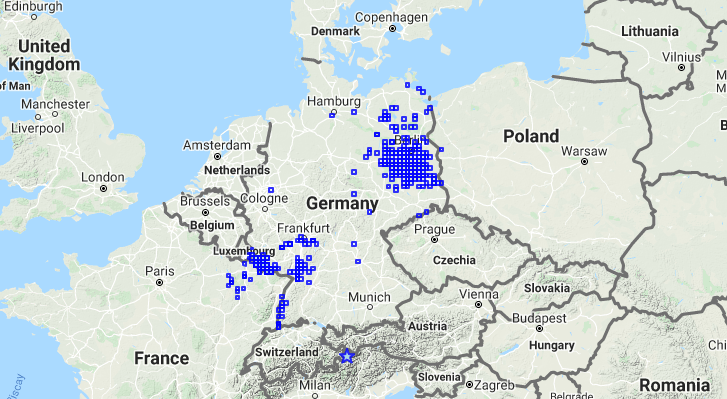 |
Yellow sac spider1 | Status LU: established. 1st record: 1988. |
 |
Getëppelten Darfanger | Status Eur.: established. |
 |
n/a | RA: ISEIA: C2. Harmonia+: n/a. |
 |
Ammendornfinger | Wikipedia:     | Wikispecies: | Wikispecies:  | wiki.arages.de | wiki.arages.de |
 |
Grote bermzakspin | Back to the list of invertebrates |
Contents
Report the species
→ Report Cheiracanthium punctorium to the National Museum of Natural History.
Brief description
 Cheiracanthium punctorium (Villers, 1789) lives in grasslands, preferring tall stalks. Being rather similar to several native Cheiracanthium species in its biology, C. punctorium should have no greater influence on the composition of native prey species in a colonised biotope. There may, however, be some competition with similar predators.
Cheiracanthium punctorium (Villers, 1789) lives in grasslands, preferring tall stalks. Being rather similar to several native Cheiracanthium species in its biology, C. punctorium should have no greater influence on the composition of native prey species in a colonised biotope. There may, however, be some competition with similar predators.
The species is known as quite aggressive when disturbed, especially pregnant or egg-protecting females. The chelicerae (fangs) of bigger individuals can easily penetrate through human skin and inject their venom. A bite of C. punctorium is painful and causes itching and swellings, and sometimes stronger reactions like vertigo, nausea, shivering, circulatory collapse and light fever. The symptoms usually decline after 24-30 hours. As the species leads a rather hidden lifestyle, the probability for bites should be rather small. There is a certain, but unfortunately sometimes overstated, media exposure of the species and its venomousness.
Status and distribution in Luxembourg
Records of Cheiracanthium punctorium (Villers, 1789) in Luxembourg. Data source: Recorder-Lux, iNaturalist & GBIF, 2024-10-22.
Cheiracanthium punctorium (Villers, 1789) was first documented in 1988 at the Aarnescht nature conservation reserve near Oberanven, municipality of Niederanven (Hermann 1998).
The species is rather thermophilous and therefore geographically restricted to the south of Luxembourg. Most observations have been made in dry grassland in the Moselle valley. Climate warming may favour further spread of the species.
Currently, 12 records of the species are accessible through the MNHNL-mdata portal; at the previously mentioned Aarnescht, and also at Roudebierg and Haard near Dudelange (MNHNL, iNaturalist & GBIF 2021).
Risk assessment
ISEIA protocol
C2 (2+2+2+1) (Ries et al. 2017: 68).
Harmonia+ protocol
Not assessed yet.
Distribution in Europe
Bibliography
- Arachnologische Gesellschaft, 2020. Atlas of the European Arachnids, accessed at https://atlas.arages.de [accessed 2020-03-05]
- Hermann, E., 1998. Die Spinnen (Araneae) ausgewählter Halbtrockenrasen im Osten Luxemburgs. Bull. Soc. Nat. luxemb. 99: 189-199. [PDF 165KB]
- MNHNL, 2000-. Cheiracanthium punctorium (Villers, 1789) in Recorder-Lux, database on the natural heritage of the Grand Duchy of Luxembourg. Musée national d’histoire naturelle, Luxembourg. URL: https://mdata.mnhn.lu [Accessed 2019-10-24]
- MNHNL, iNaturalist & GBIF, 2021. Cheiracanthium punctorium (Villers, 1789) in MNHNL-mdata, online portal combining species observation from Recorder-Lux, iNaturalist and GBIF. National Museum of Natural History, Luxembourg. URL: https://mdata.mnhn.lu [Accessed 2019-10-24]
- Ries, C., A. Arendt, C. Braunert, S. Christian, A. Dohet, A. Frantz, G. Geimer, M. Hellers, J. A. Massard, X. Mestdagh, R. Proess, N. Schneider & M. Pfeiffenschneider, 2017. Environmental impact assessment and black, watch and alert list classification after the ISEIA Protocol of invertebrates in Luxembourg. Bull. Soc. Nat. luxemb. 119: 63-70. [PDF 360 KB]
- Schneider, N., 2003. Auf Spurensuche. 22. Op der Aarnescht. Regulus 12/03: 22
- Thiel, M., 2016. Ein unheimlicher Zuwanderer. Eine südeuropäische Giftspinne zieht zunehmend nach Norden. Luxemburger Wort, 14.9.2016.
Suggested citation of this webpage
Ries, C. & M. Pfeiffenschneider (Eds.), 2024. Cheiracanthium punctorium (Villers, 1789). In: neobiota.lu - Invasive Alien Species in Luxembourg. National Museum of Natural History, Luxembourg. URL: https://neobiota.lu/cheiracanthium-punctorium/ [Accessed 2024-10-22].
Page content last updated on 2021-04-14. Last proofread by Caroline Grounds on 2019-12-05.
- Cheiracanthium punctorium is one amongst several species commonly known as the yellow sac spider. Source: https://en.wikipedia.org/wiki/Cheiracanthium_punctorium.[↩]


